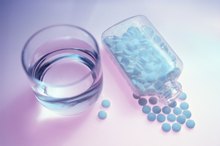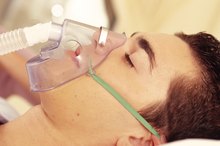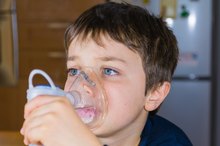Emergency Treatments for Low Blood Pressure
Low blood pressure or hypotension can refer to any blood pressure below the established normal of 120/80 mmHg as per the American Heart Association 12. However, hypotension is typically only treated when accompanied by signs and symptoms such as dizziness or lightheadedness, fainting, unusual thirst, lack of concentration, blurred vision, nausea, cool or cold, clammy and pale skin, fast breathing, general fatigue and often increased heart rate. Treatments focus on the underlying cause of the low pressure.
Positioning
Often, the quickest way to begin correcting symptomatic hypotension is by laying the hypotensive patient supine, on their back, and elevating their legs to a level above the level of their heart. If accessible, most gurneys permit the incline of the entire patient as a unit permitting the lower extremities to be elevated and the torso to be reclined. Prehospital Emergency Care refers to several positions termed shock, Trendelenburg and modified Trendelenburg positions 3. In the event the patient also experiences nausea or vomiting, this may have to involve allowing the head to remain propped to either side to avoid aspiration.
- Often, the quickest way to begin correcting symptomatic hypotension is by laying the hypotensive patient supine, on their back, and elevating their legs to a level above the level of their heart.
- In the event the patient also experiences nausea or vomiting, this may have to involve allowing the head to remain propped to either side to avoid aspiration.
Intravenous Fluids
What Causes Low Blood Pressure After Surgery?
Learn More
In situations where low blood pressure does not respond to positioning and a reversible cause cannot be identified quickly, the administration of intravenous (IV) fluids may be the recommended initial therapy 2. Often replenishing body fluids with normal saline can reverse or at a minimum stabilize hypotension until physicians can determine another cause. This typically proves most successful in situations where the cause results from decreases in blood volume, dehydration, prolonged vomiting, allergic reactions or severe infections. The use of pressure infusers, bags specifically designed to apply pressure to the outside of the IV bag and aids in forcing fluid in at a faster rate. It proves critical that too much fluid not be infused too quickly to avoid fluid overload, which can create a life-threatening situation.
- In situations where low blood pressure does not respond to positioning and a reversible cause cannot be identified quickly, the administration of intravenous (IV) fluids may be the recommended initial therapy 2.
- Often replenishing body fluids with normal saline can reverse or at a minimum stabilize hypotension until physicians can determine another cause.
Intravenous Medications
In the most severe cases of hypotension, often due to severe infections, heart insufficiency or multiple system organ failure, certain medications must be administered to increase the pumping ability of the heart. Some of the more commonly administered medications in the emergency setting include dobutamine, dopamine and norepinephrine. The New England Journal of Medicine indicates that these medications stimulate the adrenergic nervous system and in various ways increase the contacting ability of the heart, thereby increasing the force with which the heart can pump 4. Along with constriction of the vessels, these effects increase the blood pressure 2.
Other Causes of Hypotension
Cardiac Side Effects of Lithium
Learn More
In some cases the cause of the low blood pressure may result due to issues such as tachycardia, certain prescription medications or changes due to pregnancy which require monitoring and treatment as appropriate depending on the underlying cause 2. It remains important to keep in mind that prolonged low blood pressure can cause inadequate blood flow to the body resulting in myocardial infarction, strokes, renal failure and various types of shock 2. Each of these can also cause low blood pressure so it becomes crucial to treat signs and symptoms 2.
Related Articles
References
- American Heart Association: Low Blood Pressure
- Mayo Clinic: Low Blood Pressure
- "Prehospital Emergency Care, 9th Ed.", Mistovich, J., et al., 2009
- New England Journal of Medicine: Vasopressors
- National Heart, Lung, and Blood Institute. Low blood pressure.
- National Heart, Lung, and Blood Institute. Low blood pressure.
- National Kidney Foundation. Acute Kidney Injury (AKI).
- Jensen MT, Suadicani P, Hein HO, Gyntelberg F. Elevated resting heart rate, physical fitness and all-cause mortality: a 16-year follow-up in the Copenhagen Male Study. Heart. 2013;99(12):882-887. doi:10.1136/heartjnl-2012-303375
- Whelton PK, Carey RM, Aronow WS, et al. 2017 ACC/AHA/AAPA/ABC/ACPM/AGS/APhA/ASH/ASPC/NMA/PCNA Guideline for the prevention, detection, evaluation, and management of high blood pressure in adults: a report of the American College of Cardiology/American Heart Association Task Force on clinical practice guidelines. Hypertension. 2018;71(6):e13-e115. doi:10.1161/HYP.0000000000000065
- Michiels C. Physiological and pathological responses to hypoxia. Am J Pathol. 2004;164(6):1875-82. doi:10.1016/S0002-9440(10)63747-9
- Saljoughian M. Hypotension: A clinical care review. US Pharm. 2014;39(2):2-4.
- Kasper DL, Fauci AS, Stephen L. Harrison's Principles of Internal Medicine. New York: Mc Graw Hill Education, 2015.
Writer Bio
Eugene Elliott is a critical-care paramedic and senior emergency management/public health/environmental analyst. With experience in public safety, public health and incident response, Elliott has been an educator and writer for more than 10 years, affiliated with the American Public Health Association, Virginia Public Health Association and the National Emergency Management Association. He holds degrees in biology, public health/administration and emergency management.









